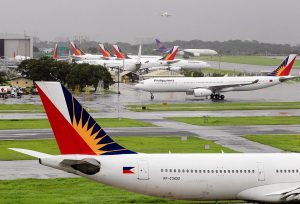PAL earnings more than double on higher travel demand

By Ashley Erika O. Jose, Reporter
PAL Holdings, Inc., the listed operator of flag carrier Philippine Airlines (PAL), saw its attributable net income more than double to P16.81 billion last year, driven by heightened passenger volume and route expansions.
The company’s net income for 2023 rose to P16.81 billion from P8.16 billion a year ago, it said in a regulatory filing on Monday.
PAL’s passenger revenue increased by 37% to P160 billion in 2023 from P114 billion in 2022, boosting the company’s overall revenues.
The company said that higher revenues offset the increase in gross expenses as its top line climbed to P179.12 billion, marking a 28.6% increase, citing a “significant” rise in passenger volume compared to its previous combined revenues of P139.24 billion.
The company flew a total of 14.7 million passengers in 2023, a 58% jump from last year’s 9.3 million passenger count.
Data provided by the Civil Aeronautics Board (CAB) showed that PAL’s subsidiary PAL Express’ passenger volume rose to 7.77 million from 3.84 million in 2022.
The flag carrier also managed to operate about 105,294 flights in 2023, a 36% climb from 77,533 flights in 2022.
The company said its combined expenses went up by 23.9% to P151.04 billion from P121.93 billion in 2022 after operating more flights for the period.
PAL operated two new routes such as the Manila-Perth and Cebu-Laoag flights and it also relaunched 13 flights last year.
In 2023, PAL’s jet fuel consumption went up by 8% due to the increase in flight activity, the company said, adding that fuel costs accounted for the 45.3% share of its overall revenues.
The construction of two new Mabuhay lounges in Manila and Cebu, along with the refurbishments of all its other lounges in the Philippines, were also factored into the company’s higher expenses for the period.
Its maintenance expenses went up by 39.1% to P22.14 billion from P15.91 billion in 2022 due to higher aircraft utilization.
For 2024, PAL targets to capitalize on the increased resources to further strengthen its global and local network, while also upgrading its aircraft fleet and adding new aircraft in the next few years.
“To preserve the gains we have achieved, we must not rest on our laurels. PAL’s corporate transformation continues — we are taking in new aircraft, retrofitting cabins of current aircraft, upgrading airport lounges, and introducing more product innovations to address our strategic, financial, and operational needs across all areas of our operations,” Stanley K. Ng, president and chief operating officer of PAL, said in a separate media release.
The substantial increase in income of listed airline companies demonstrate improved operational efficiency and cost management, Globalinks Securities and Stocks, Inc. Head of Sales Trading Toby Allan C. Arce said.
“Despite a considerable rise in total operating expenses, primarily driven by higher fuel costs and fleet-related expenses,” Mr. Arce said in a Viber message.
“PAL’s growth prospects appear promising, supported by its strengthened financial position, improved operational efficiency, and the anticipated rebound in travel demand post-pandemic.”
To recall, CAB recorded a total of 50.18 million passenger volume for 2023 covering both domestic and international flights.
The Tourism department reported 5.45 million international visitors in 2023, surpassing the year’s target of 4.8 million.
For 2024, the department aims to attract 7.7 million international visitors.
PAL must take advantage of its route expansions and strategic customer offerings to sustain the company’s growth, Mr. Arce noted.
Strategic alliances, route expansions, and enhanced customer offerings could further drive PAL’s growth in the coming years.
“Maintaining cost-effective operations, optimizing fleet utilization, and enhancing service quality will be essential for profitability and competitiveness,” he said.
Additional fleet investments, route expansions could also unlock new growth opportunities for the company, Mr. Arce said, adding that monitoring fuel prices, currency fluctuations, and regulatory changes will be important to mitigate risks and capitalize on favorable market conditions.
“While challenges persist, [airline companies] have demonstrated resilience and potential for growth. By focusing on operational excellence, strategic initiatives, and market responsiveness, airlines can sustain their growth momentum in the dynamic aviation industry,” Mr. Arce said.




